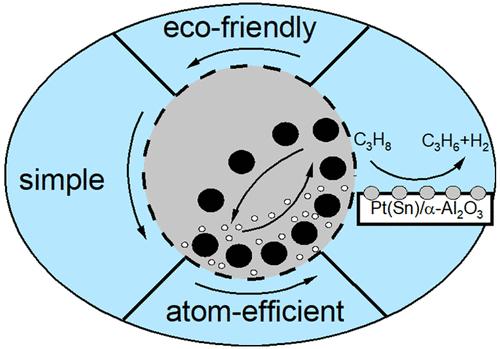当前位置:
X-MOL 学术
›
Ind. Eng. Chem. Res.
›
论文详情
Our official English website, www.x-mol.net, welcomes your
feedback! (Note: you will need to create a separate account there.)
A Facile Approach to Alumina-Supported Pt Catalysts for the Dehydrogenation of Propane
Industrial & Engineering Chemistry Research ( IF 3.8 ) Pub Date : 2024-11-19 , DOI: 10.1021/acs.iecr.4c02577 Nils Pfister, Iana Kraievska, Christian Rohner, Jinhu Dong, Olaf Timpe, Frank Girgsdies, Thomas Lunkenbein, Rohini Khobragade, Jacopo De Bellis, Ferdi Schüth, Annette Trunschke
Industrial & Engineering Chemistry Research ( IF 3.8 ) Pub Date : 2024-11-19 , DOI: 10.1021/acs.iecr.4c02577 Nils Pfister, Iana Kraievska, Christian Rohner, Jinhu Dong, Olaf Timpe, Frank Girgsdies, Thomas Lunkenbein, Rohini Khobragade, Jacopo De Bellis, Ferdi Schüth, Annette Trunschke

|
The catalytic dehydrogenation of propane is an economically interesting process for the production of propylene due to its high selectivity to the olefin and the coupled generation of hydrogen. The catalysts are usually obtained by depositing the active components from solutions onto a support. Here we show that the direct synthesis of alumina-supported platinum catalysts in a ball mill in a single step provides easy access to efficient catalysts that are comparable in performance to materials obtained by more complex synthesis techniques. This was demonstrated by analysis using XRD, N2 adsorption, chemical analysis, FTIR spectroscopy, and electron microscopy and by functional characterization of the catalysts in the dehydrogenation of propane to propylene. Although the ball milling procedure was not optimized, the catalysts exhibit a narrow Pt particle size distribution around 2 nm and are active at comparatively low reaction temperatures, producing in the steady state at 500 °C approximately 300 gpropylene gPt-1 h–1. The selectivity remains very high even at temperatures as high as 550 °C. Sintering of Pt under the harsh reaction conditions is not observed. The scalable method saves energy and avoids waste as no solvents and no thermal or reducing pretreatments are required.
中文翻译:

用于丙烷脱氢的氧化铝负载 Pt 催化剂的简单方法
丙烷的催化脱氢是一种经济上有趣的丙烯生产工艺,因为它对烯烃具有高选择性和耦合生成氢气。催化剂通常是通过将溶液中的活性组分沉积到载体上来获得的。本文表明,在球磨机中一步直接合成氧化铝负载的铂催化剂,可以轻松获得高效的催化剂,这些催化剂的性能可与通过更复杂的合成技术获得的材料相媲美。通过使用 XRD、N2 吸附、化学分析、FTIR 光谱和电子显微镜进行分析,以及通过丙烷脱氢制丙烯中催化剂的功能表征来证明这一点。尽管球磨工艺未得到优化,但催化剂在 2 nm 左右表现出较窄的 Pt 粒径分布,并且在相对较低的反应温度下具有活性,在 500 °C 的稳态下可产生约 300 g丙烯 g Pt-1 h–1。即使在高达 550 °C 的温度下,选择性也保持非常高。 在恶劣的反应条件下未观察到 Pt 的烧结。这种可扩展的方法可以节省能源并避免浪费,因为无需溶剂,也不需要热处理或还原预处理。
更新日期:2024-11-19
中文翻译:

用于丙烷脱氢的氧化铝负载 Pt 催化剂的简单方法
丙烷的催化脱氢是一种经济上有趣的丙烯生产工艺,因为它对烯烃具有高选择性和耦合生成氢气。催化剂通常是通过将溶液中的活性组分沉积到载体上来获得的。本文表明,在球磨机中一步直接合成氧化铝负载的铂催化剂,可以轻松获得高效的催化剂,这些催化剂的性能可与通过更复杂的合成技术获得的材料相媲美。通过使用 XRD、N2 吸附、化学分析、FTIR 光谱和电子显微镜进行分析,以及通过丙烷脱氢制丙烯中催化剂的功能表征来证明这一点。尽管球磨工艺未得到优化,但催化剂在 2 nm 左右表现出较窄的 Pt 粒径分布,并且在相对较低的反应温度下具有活性,在 500 °C 的稳态下可产生约 300 g丙烯 g Pt-1 h–1。即使在高达 550 °C 的温度下,选择性也保持非常高。 在恶劣的反应条件下未观察到 Pt 的烧结。这种可扩展的方法可以节省能源并避免浪费,因为无需溶剂,也不需要热处理或还原预处理。


















































 京公网安备 11010802027423号
京公网安备 11010802027423号